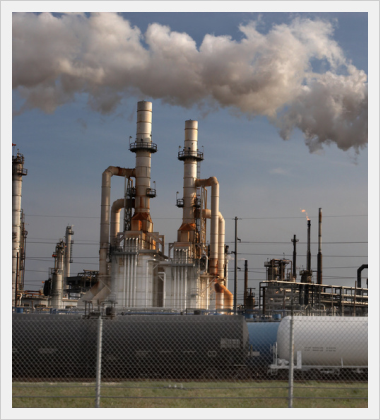
If you had to choose just one tool to use for managing environmental impacts from your Oil and Gas production sites, what would it be?
What singular system or piece of technology would help you make sure you didn’t go over your emission limits, help prevent malfunctions, avoid fines, and give you a clear picture of your environmental footprint?
After two decades of designing and implementing Environmental Management Systems (EMSs), we’ve found that the most powerful tool in an EH&S Manager’s toolbox is automated emissions data uploads from their sites using a smart EMS linked to Continuous Monitoring Systems and combining it with automated alerts.
There is nothing quite like getting minute-by-minute emissions data direct from your sites to give you control over your operations – even if your sites are located several states away from your head office.
This guide will give you an overview of the essentials for tapping into the benefits of automated continuous monitoring, including:
- The different types of Continuous Monitoring System (CMS) Equipment
- Why automation works particularly well for the Oil and Gas industry
- How continuous monitoring helps avoid crises and malfunctions
- How to put automated continuous monitoring to work for your business
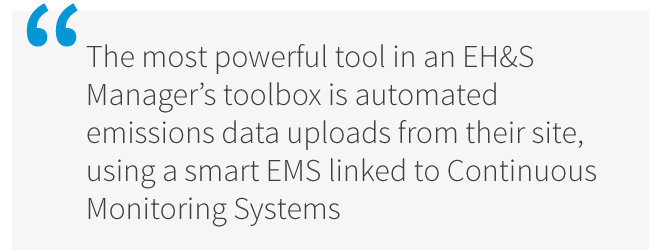
Types of Continuous Monitoring Equipment
Continuous Monitoring System (CMS) equipment typically comes in two types: Continuous Emissions Monitoring (CEM) and Continuous Parametric Monitoring (CPM).
CEM equipment is used to measure and record emissions data captured from the outflow of the stack or emission point to which the CEM is installed. For example, you may have a CEM device installed on a stack that keeps track of its SO2 emissions by measuring air flow and concentration in order to calculate the SO2 emissions at any given moment. Another type of CEM might measure the opacity of the outflow from an emission point to determine how much particulate matter leaves through that stack. This form of CEMS is also known as Continuous Opacity Monitoring (COM)
CPM equipment, on the other hand, measures the operational parameters of your equipment and control devices. CPM can be used to measure any number of operating conditions (like temperature, air pressure, etc.) in order to keep track of how well a piece of equipment is performing.
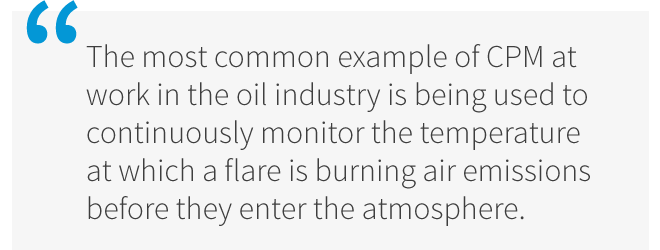
One of the most common examples of CPM at work in the oil industry is being used to continuously monitor the temperature at which a flare is burning air emissions before they enter the atmosphere. If the flare falls below a certain temperature, then the outflow from that point may contain hazardous and volatile compounds that haven’t been properly combusted. Checking the CPM records will tell you if your flare and control equipment are doing their job correctly at any given moment.
The types of CMS you have installed at your facility will vary according to your needs and the type of processes your sites undertake. Some permits may require the use of CMS devices for specific control technologies, and some facilities choose to implement a CMS setup voluntarily, because they want to be 100% confident that their operations are running smoothly and/or they want to be good environmental stewards.
Why Automated Data Retrieval Makes a World of Difference
While installing a CEM or CPM system on site is a powerful first step in capturing the most accurate EH&S data possible for your business, there’s an important second step that should never be overlooked: automating data collection and analysis from those CMS devices.
CMS equipment records operating data, but leave it up to you to choose how and when to use that data. If a CMS is essentially a very accurate and time-specific data generating device, then it’s in how you use that data that it becomes truly useful.
Creating an automated connection between your EH&S central operations and your CEM/CPM equipment transforms those devices into active tools rather than data receptacles. Instead of simply compiling data on site, an automated Continuous Monitoring System can directly upload important minute-by-minute data to your EH&S headquarters. Almost like having a dedicated Environmental Manager on site, 24/7.
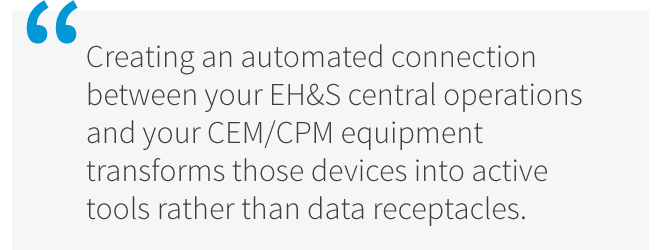
Imagine the potential of having your CMS upload emissions data as often as every minute into your EH&S database where key decision makers can review it and plan accordingly. If your site begins approaching an emission limit you’ll know long before you reach it. If a piece of equipment is dropping below permitted operating parameters, you’ll see it happen and have the opportunity to prevent noncompliance.
Without an automated upload connection for your CEM/CPM systems you’ll be stuck with a wealth of data but still have to travel long distances or wait unpredictable periods to harvest it. You might not get that valuable CMS data until after a malfunction or noncompliance event if you only think to check in with your CMS equipment after the fact.
Think of automation and continuous monitoring this way: if you’re going to invest in CMS technology, it just makes good sense to maximize your benefits.
Don’t just settle for excellent data quality: opt for excellent access to that data as well.
How Automated Data Analysis Could Save Your Business
In addition to having your emission data transferred directly to your EH&S department in near real-time, Continuous Monitoring System data can also be analyzed on an automated schedule to warn you about approaching emission limits and other thresholds.
If you connect your CMS devices to an automation system, it is possible to have that system read the incoming data and compare it with your internal limits. For example, if your permit dictates that a certain site or source has an emission limit associated with it, your Continuous Emissions Monitoring System data can warn you the minute that your emissions approach that limit. You’ll get an email alert warning you that your operations are approaching a noncompliance situation that you can prevent before it becomes a problem.
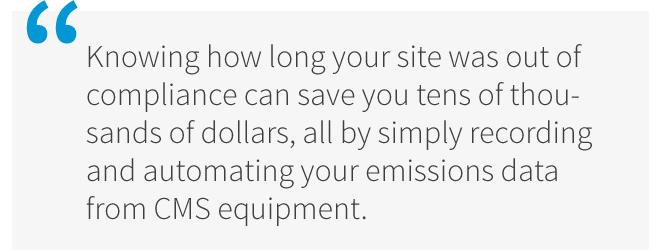
The same proactive automation approach can be taken using a Continuous Parameter Monitoring System (CPMS) to actively monitor equipment and prevent control device malfunction and shutdowns. If a flare drops dangerously close to falling out of the approved temperature in your permit you’ll get a warning email so that you can act before the device stops operating at peak efficiency.
And in those cases where a sudden and unpreventable malfunction occurs, having a CMS setup will still help you minimize fines and fugitive emissions, as well as speed up the recovery process after the MSS event.
CMS records will be able to inform you about the amount and type of emissions released during an MSS event and – equally important – the exact minute that the event began and ended. In general EH&S managers overestimate how long they were out of compliance in their violation reports (sometimes by as much as 300%) in order to avoid compounding their fines, but with a CMS recording each minute of the event you’ll know exactly how many minutes to report.
Knowing how long your site was out of compliance can save you tens of thousands of dollars, all by simply recording and automating your emissions data from CMS equipment.
Why Automated Continuous Monitoring Works Particularly Well for Oil & Gas
Although any type of facility will benefit from the addition on automated data collection from Continuous Monitoring Systems, there are particular challenges that the Oil & Gas Industry faces that are more easily overcome through CMS automation.
For example, one Oil & Gas company can have hundreds of tank batteries spread out over several states, hours of travel away from the main office of EH&S operations. One EH&S manager could be in charge of reporting and permitting for a number of states, yet have no immediate access to the environmental data from those distant facilities.
They typically have to travel themselves, or wait several weeks for an on-site employee to capture emissions information and transfer it. That’s even if they have a CMS device installed – otherwise the wait times are even longer and the data sent over is far less accurate.
However, with an automated CMS installed, the important data from those far off sites can be sent over every minute (or hour, or day – as frequently as you see fit), which means you’ll convert days or weeks of wasted waiting into productive time. Automating your Continuous Monitoring Systems bridges the gaps of time and distance that are so endemic to the Oil & Gas Industry.
The quality of data that CMS devices can capture is of exceptional quality and that is vitally important for the Oil & Gas Industry since it faces stricter regulations than most others. Because environmental regulators and green watch groups pay more attention to the Oil & Gas industry, it is in your best interest to have solid evidence of your responsible business practices, dedication to environmental regulations, and stewardship.
How to Get Automation Working for You
There’s three parts to enjoying the benefits of automated continuous monitoring: first, installing CMS devices for the sites, processes, and equipment that you want to gain complete control over. Second, develop a singular EH&S database for your environmental managers that all the CMS data can be collected into. Having this central database is vitally important for the Oil & Gas industry with a diverse portfolio of responsibilities spread out over several sites.
Finally, create a secure online connection between the CMS devices and your central EH&S database. How this final step will be accomplished will depend on the type of CMS devices and the digital platform your database is built on.
We recommend that you rely on an experienced EH&S solution provider to walk you through or design your centralized database and all of its automated functionality. Programming a complex database that handles several sites’ needs without becoming difficult to navigate can be a difficult and costly affair otherwise. If you’re already taking the first step by investing in CEM or CPM technology, it’s worth considering implementing an EH&S solution with built-in CMS automation capabilities from a professional developer.
Automation is arguably the most powerful tool that an EH&S Manager can ask for, and when that technology is paired with an Environmental, Health & Safety database platform that can tap into CMS data, the result is a winning combination for the Oil & Gas Industry.
If you're interested in how ERA's platform can automate your EH&S tasks, you can request a personalized demo with an environmental specialist today.
Ask an ERA Expert:
Do you have any questions or concerns about the topic covered in this article? Want more insight? Now is your chance to ask one of ERA’s Environmental Specialists. Please leave your question or comment below and we’ll make sure one of our expert scientists responds.
This Blog Was Co-Authored By:


Tags:
Environmental Management
March 19, 2014

Comments